Chickens with bleeding bottoms or vents.

This is the sort of problem that can have a chicken keeper seeing it for the first time in blind panic. This article contains graphic images.
Luckily bleeding vents in poultry is relatively rare has a few causes that are easily treatable as well as one or two that are not.
The general signs that something is wrong are similar to those associated with pain. A lack of appetite, lethargy, huddling with fluffed up feathers or refusing to come of the perch or out of the coop.
CAUSES OF A BLOODY BOTTOM IN CHICKENS:
- Pecking - The vent in young hens can be red and swollen after laying an egg and other birds will peck at it.
- Egg laying - This normally happens when you find a blood smeared egg in the nest.
- Prolapse - This is serious. The vent or cloaca is pushed out of the hen during egg laying to various degrees.
Unless you are experienced and know what you are dealing with then you should take the advice of a vet. This is not always easily diagnosed or treated.
Below: Clean and clear with nothing to worry about.
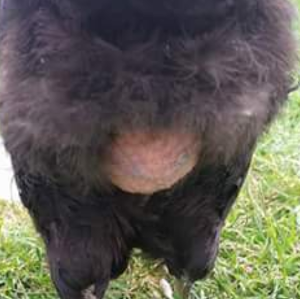
This is a plain backside that is just devoid of feathers. Provided there are no mites or signs of pecking it can be left alone.
Solution to bloody bottom feathers.
Firstly trim the feathers to see the area clearly. Clean the bottom with warm water. Your never really going to see what the injury is with all the bloody feathers in the way.
Below: Get some gloves on and clean the bird then trim the feathers around the vent.
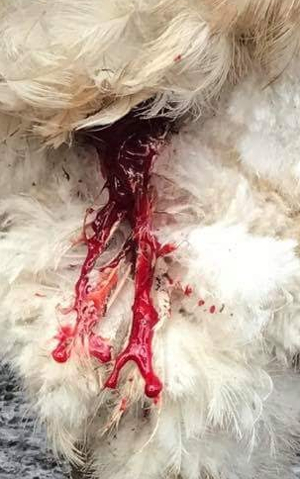
Feather pecking:
If it is pecking then separate the bird and clean the affected area. Treat with purple spray and allow a week or so to heal before reintegration. below is a bird with it's feathers pecked off. It tends to look very different from a bleeding vent.
Below: This is feather pecking.
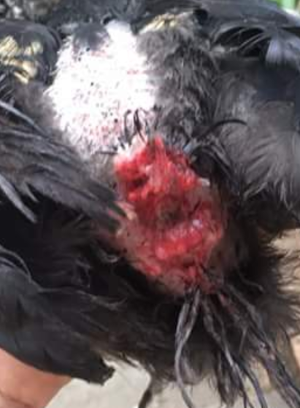
You will also need to treat the cause of the feather pecking by adding distractions and amusements and increasing protein in the diet.
Ways to entertain your chickens:
- Hang a cabbage or sweetcorn in the run.
- Set chicken scratch in suet to make a peck block.
- Provide perches and swings or rope.
- Lower the light level in the coop a little or tint the windows red.
- Dust baths
- Plant a tree in the run – Willow is a good choice.
Bloody eggs:
Young hens will often burst a blood vessels when they first begin to lay eggs and getting a blood smeared egg and bloody feathers is quite common in POL hens. This end up with an egg that looks like this one below. There is nothing wrong with the contents of the egg and it rarely persists beyond an egg or two.
Below: An egg smeared with blood from a burst vessel.
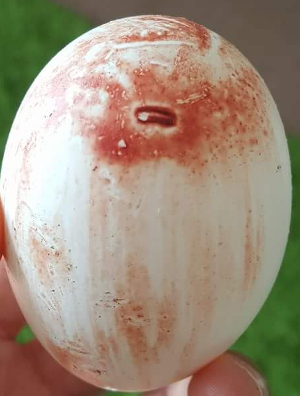
Bleeding caused by egg laying doesn't tend to flow and stain the feathers.
This generally will only happen once or twice with the first full size egg the bird lays and will clear up quickly.
Keep a close eye on the chickens and monitor for abnormal eggs.
A young Pullet laying a blood smeared egg is unlikely to show any other symptoms.
Rough egg shells can cause and exacerbate any of these conditions.
PROLAPSE:
Prolapse of the vent or cloaca is a serious condition which often leads to the death of the bird within 24 hours or less if left untreated.
Below: A prolapse can be a harrowing experience and more often than not fatal.
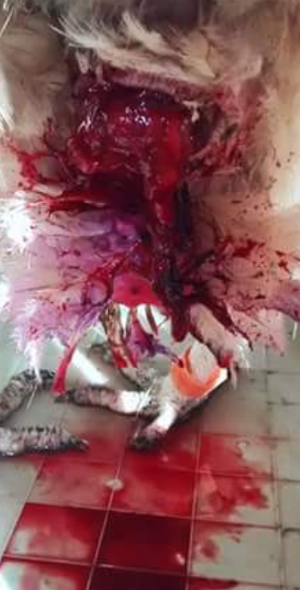
It is quite natural for the vent to protrude a little during the egg laying process, you can see this on any video of an egg being laid.
Not surprising really as it essentially means the egg tubes and some of the internal organs lapse out of the body. It can be quite a horrific sight especially for the newbie keeper.
Diagnostic signs - Parts of the internal reproductive tract protrude from the vent. If the chicken has been cannibalised by flock mates, the vent may also be bloody or torn.
Common causes of the prolapse:
- Calcium deficiency can cause eggs to break or have rough shells.
- Fat or obese chickens. Yes the do exist.
- Young hens or hybrids that start laying very young.
- Undernourished or poorly fed birds.
- Older chickens are more susceptible.
Treatment of of the prolapse:
It is treatable if caught early and requires a few stitches to hold the organ in place and medication to stop the hen laying for three months. It is common in ex battery hens and I have only seen it once in my rare breed hens.
Once left to become swollen or dirty or if the prolapse has been picked by other hens the chance of success is much smaller.
There are ways of treating it at home but unless the laying process is interrupted it will pop straight out again. Giving less than 10 hours daylight will stop the egg s within a week or two normally but that is still 7 to 14 eggs passing through a damaged system.
Prolapses can be classified by how much of the internals have been extruded. anything from a bulge ( mild) to complete ( extreme).
There is a high likely hood of it happening a second time.
Remember when treating chickens:
- Cover them in a towel to keep them dark and stop the flapping and hurting themselves.
- Know your limits and call a veterinarian if you need to.
- Get someone to help you.
- Separate them from the other hens, a large cat carrier or dog cage will do.
- Do not be in a rush to get them laying by giving lots of extra light early in the year.
- Keep them in the dark for more than half the day. 10 hours daylight is the max.
